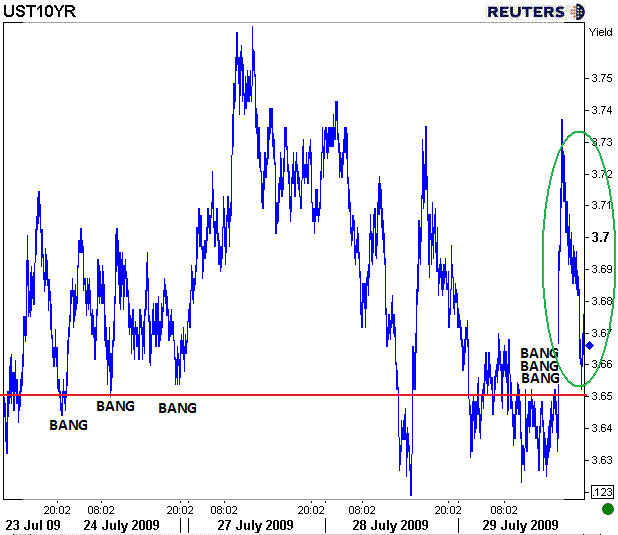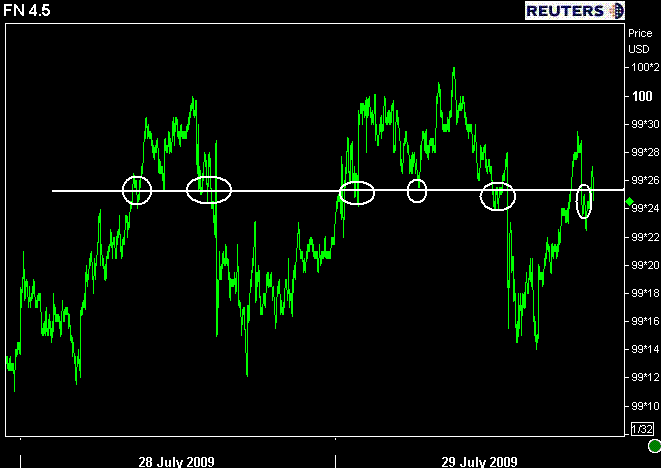HAHA...this is getting funny.
Following the crappy 5 yr note auction....the long end of the yield curve sold off and "rate sheet influential" MBS prices ticked considerably lower. This prompted us to issue an ALERT that lenders were likely to reprice for the worse. After that...the 10 yr started to recover from the post auction "knee jerk" reaction sell off. We started getting a little excited as the 10 yr note made its way all the way back down to 3.65% (green circle). But guess what happened...
BANG BANG BANG!!!

The reaction from MBS? A BOUNCE back to 99-30. Then a FAIL and fall back to 99-22. Then a BOUNCE back to 99-28. Then FAIL and fall back to 99-24. Then BOUNCE back to 99-26. Nice little narrowing range developing. Hmm...99-25 has been decent focal point in last two days. You think we close near there today? Probably...if the 10 yr heads back towards 3.65%.

I suppose some lenders may give back a few bps from the most recent wave of reprices for the worse. Ahhhh volatility is fun isnt it?
The Beige Book was also just released. Not too many surprises. More of the same stabilization sentiment. I did bold some tapebombish verbiage regarding commercial real estate. Here are some excerpts:
"Most Districts reported sluggish retail activity."
"Reports from the 12 Federal Reserve Districts suggest that economic activity continued to be weak going into the summer, but most Districts indicated that the pace of decline has moderated since the last report or that activity has begun to stabilize, albeit at a low level. Five Districts used the words "slow", "subdued", or "weak" to describe activity levels"
"Consumer spending in the early summer remained below previous-year levels in most Districts, as households continued to be price conscious."
"Reports on the manufacturing sector remained subdued but were slightly more positive than in the previous Beige Book. Many Districts characterized manufacturing activity as remaining depressed but with selected signs of modest improvement."
"Commercial real estate leasing markets were described as either "weak" or "slow" in all 12 Districts, although the severity of the downturn varied somewhat across Districts."
"While the office vacancy rate was up and rents were down in the Dallas District, market fundamentals there remained stronger than the national average. Market conditions in the New York District are significantly worse than one year ago, on average, but have been relatively stable in recent weeks and some parts of the District report improving fundamentals"
"Commercial real estate sales volume remained low, even "non-existent"
in some Districts, reportedly due to a combination of tight credit and
weak demand. Construction activity was limited and/or declining in most
Districts"
Residential real estate markets in most Districts remained weak, but many reported signs of improvement.
In most reporting Districts, overall lending activity was stable or weakened further for most loan categories.
Banks continued to tighten credit standards in the New York,
Philadelphia, Richmond, Chicago, Kansas City, Dallas, and San Francisco
Districts; and some have stepped up the requirements for the commercial
real estate category, in particular, due to concern over declining loan
quality.
All Districts indicated that labor markets remain slack, with most
sectors either reducing jobs or holding them steady and aggregate
employment continuing to decline, on net.
The weakness of labor markets has virtually eliminated upward wage
pressure, and wages and compensation are steady or falling in most
Districts; however, Boston cited some manufacturing and business
services firms raising pay selectively, and Minneapolis said wage
increases were moderate.
2s vs. 5s: 147bps
2s vs. 10s: 249bps
5s vs. 10s: 102bps
PS...The Federal Reserve just published "5 Tips When Shopping for a Mortgage" .





